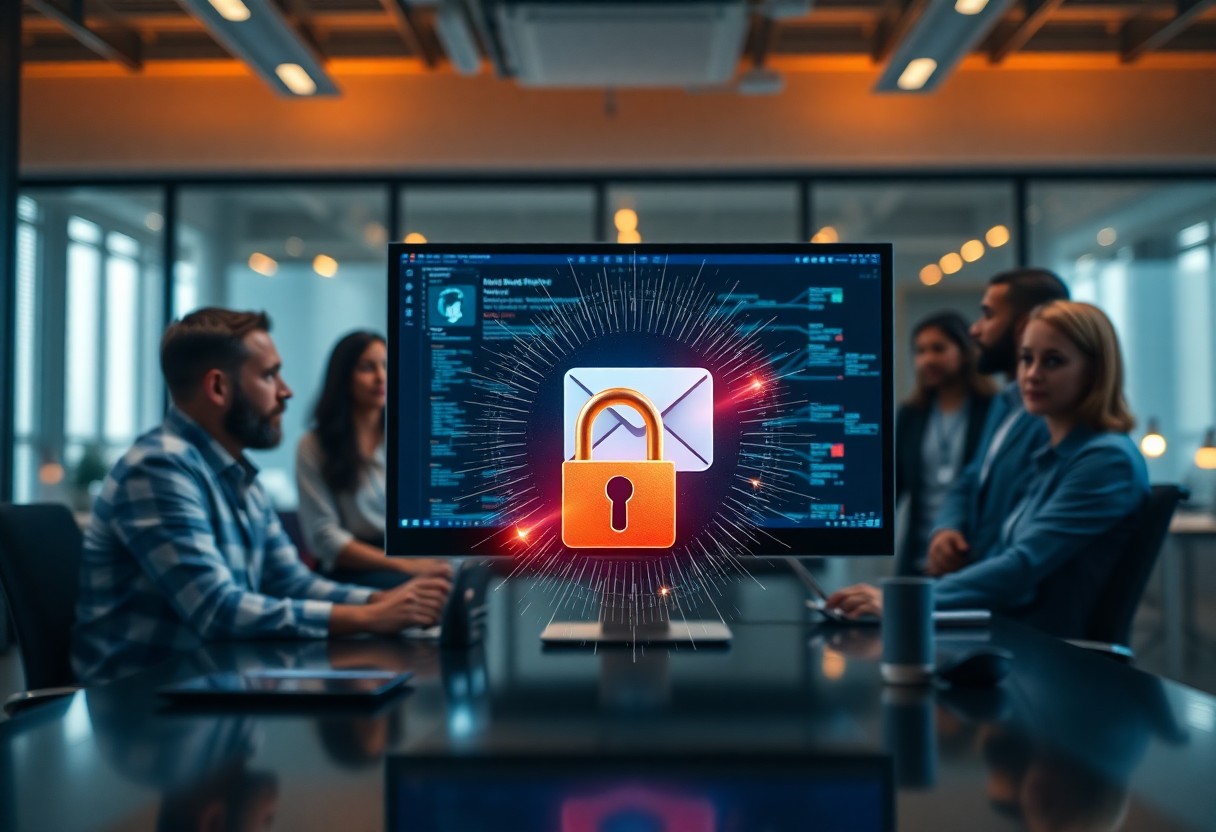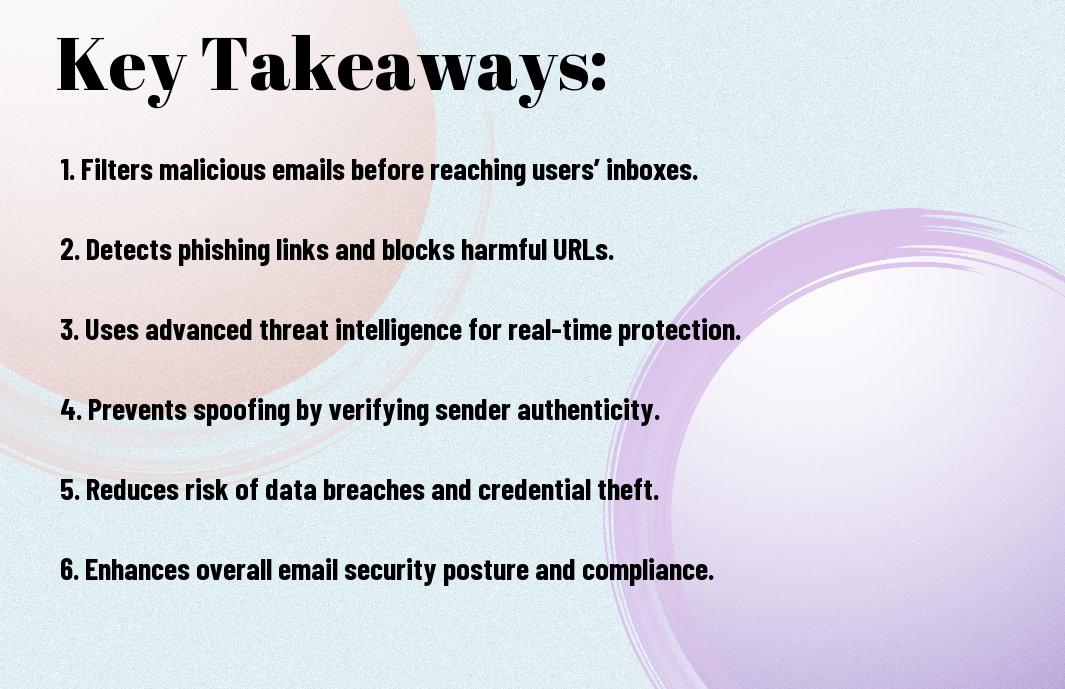Security is paramount in today’s digital landscape, especially when it comes to defending your organization against phishing attacks. A secure email gateway serves as a powerful line of defense, filtering out malicious emails before they reach your inbox. By integrating advanced threat detection and email filtering technologies, you can safeguard your sensitive information and maintain your organization’s integrity. In this blog post, we will explore how implementing a secure email gateway can enhance your protection against phishing schemes, ensuring a safer communication environment for you and your team.
Key Takeaways:
- A secure email gateway filters incoming emails to block potential phishing threats before they reach users’ inboxes.
- Advanced threat detection technologies, such as machine learning and AI, enhance the ability of secure email gateways to identify and neutralize sophisticated phishing attempts.
- Regular updates and real-time threat intelligence keep the secure email gateway adept at responding to emerging phishing tactics and techniques.
- By providing comprehensive logging and reporting, a secure email gateway helps organizations analyze phishing attempts and improve overall security posture.
- Training and awareness programs in conjunction with a secure email gateway educate employees on recognizing phishing scams, creating a multi-layered defense.

The Mechanisms of Email Threats
Email threats have evolved, presenting increasingly sophisticated challenges for organizations. Phishing, among the most prevalent attacks, exploits trust in familiar communication channels to deceive users. Attackers employ a variety of tactics to manipulate recipients, using malware, credential harvesting, or financial fraud. With the increasing reliance on email for business operations, these threats can lead to severe data breaches and significant financial losses if not adequately safeguarded.
Dissecting Phishing Techniques: How Scammers Operate
Phishing techniques often involve deceptive emails that mimic legitimate communications from trusted entities. They may incorporate urgent language, fake website links, or requests for sensitive information. For example, a scammer might send an email designed to look like it’s from your bank, prompting you to click a link and input your login credentials. The design may be so convincing that you might not even question its authenticity, demonstrating the lengths to which scammers will go to steal your information.
The Role of Social Engineering in Email Attacks
Social engineering is fundamental to many email attacks, leveraging psychological manipulation rather than technical vulnerabilities. Scammers tailor their messages to exploit emotions such as fear, urgency, or curiosity, influencing you to act quickly without questioning the request. For instance, you might receive an email claiming that your account will be suspended unless you verify your details immediately, prompting hasty action that results in compromised information.
In many cases, scammers research potential targets to craft messages that appeal specifically to their interests or professions, enhancing the likelihood of success. An attacker may send an email appearing to originate from a trusted colleague, addressing your recent project discussions and urging you to download an attached document for further details. This tailored approach increases the effectiveness of their schemes by creating a false sense of trust and urgency, capitalizing on your natural inclination to respond promptly to work-related communications.

The Architecture of a Secure Email Gateway
A well-designed secure email gateway typically consists of several layers of security protocols and technologies aimed at filtering out malicious content before it ever reaches your inbox. These architectures usually incorporate components such as spam filters, antivirus engines, and advanced threat detection systems. By analyzing inbound and outbound emails using machine learning algorithms and heuristic rules, these gateways effectively create a fortified barrier against phishing attempts, ensuring your organization’s communication remains safe.
Core Features That Mitigate Phishing Risks
Key features of a secure email gateway include URL filtering, attachment scanning, and sender authentication. URL filtering checks links in emails against blacklists and real-time threat feeds, while attachment scanning inspects files for malware. Sender authentication methods like SPF, DKIM, and DMARC verify the legitimacy of the sender, significantly reducing the chances of falling victim to phishing schemes.
Integration with Existing Security Protocols: A Seamless Approach
Integrating a secure email gateway with your existing security protocols enhances overall protection without requiring a major overhaul of your current systems. This seamless integration allows you to bolster your defense mechanisms by leveraging existing firewalls, endpoint protection solutions, and incident response plans, ultimately creating a comprehensive security ecosystem.
With the right email gateway in place, you can easily integrate it with existing security measures such as SIEM systems and intrusion detection solutions. This allows the gateway to share threat intelligence in real time, enabling quicker responses to emerging threats. For example, if a phishing attempt is detected, the secure email gateway can alert your firewall and other security layers, triggering additional protective actions. This synergistic approach not only enhances operational efficiency but also fosters greater resilience against phishing attacks, giving your organization a robust defense that adapts to the evolving threat landscape.
Real-Time Defense: How Secure Email Gateways Filter Threats
Secure email gateways provide a robust, real-time defense mechanism against threats by continuously monitoring incoming emails. By employing advanced algorithms, these gateways assess emails for suspicious links, attachments, and sender reputation. This proactive filtering mechanism ensures that harmful emails are identified and quarantined before they can reach your inbox, thereby reducing the risk of phishing attacks and data breaches within your organization.
Predictive Analysis and Pattern Recognition
Predictive analysis and pattern recognition are integral components of secure email gateways, enabling them to learn from past threats. By studying historical data, these systems identify patterns that characterize phishing attempts. When an email resembles these patterns, it raises an alert, allowing your security measures to take immediate action against potential risks.
User Behavioral Analytics: Detecting Anomalies
User behavioral analytics empower secure email gateways to detect atypical actions, which may signal phishing attempts. By monitoring how you and your colleagues typically interact with emails, the system creates a baseline of normal behavior. Any deviation, such as an unusual login location or accessing attachments outside of usual working hours, triggers alerts for further investigation.
Data-driven insights showcase how user behavioral analytics significantly enhance your organization’s security. For instance, if an employee suddenly interacts with emails from unfamiliar contacts at odd times, the system flags this behavior as a potential threat. This approach has proven effective; organizations employing these analytics have reported a 30% reduction in successful phishing attacks. By focusing on individual user patterns, you can bolster your defenses and respond swiftly to emerging threats before they escalate into serious issues.
Beyond Protection: Enhancing Organizational Security Culture
Fostering a secure organization extends beyond implementing a secure email gateway; it involves cultivating a proactive security culture that empowers every employee to take responsibility for safeguarding sensitive information. Encouraging open communication regarding threats and establishing a mindset that prioritizes security can significantly reduce vulnerabilities. By integrating security protocols into daily operations and emphasizing shared ownership of security practices, your organization can create a resilient environment ready to counteract phishing attempts and other cyber threats.
Employee Training and Awareness Programs
Regular employee training and awareness programs form the backbone of an effective security culture. By arming your staff with knowledge about the characteristics of phishing attempts, you enable them to identify suspicious emails and act accordingly. These programs should include real-life scenarios, interactive sessions, and ongoing assessments to ensure staff remain vigilant and informed about emerging threats.
Building a Resilient Response Plan to Phishing Attempts
A well-structured response plan is necessary for effectively managing phishing attempts when they occur. This plan should outline clear steps on how your organization will respond to various phishing scenarios, including immediate notification protocols, investigation procedures, and remediation efforts. Engaging team members in simulation exercises can reinforce the response strategy and prepare them for real incidents, thereby minimizing potential damages.
An effective response plan not only enhances your organization’s recovery capabilities but also instills confidence among employees. Incorporate elements such as designated response teams responsible for tracking phishing incidents, central communication channels for reporting suspicious messages, and regular updates aimed at refining your strategies based on previous incidents. By fostering a culture of vigilance and preparedness, your organization can swiftly mitigate the risks associated with phishing, ultimately reinforcing a unified front against cyber threats.

Evaluating the Efficacy of Secure Email Gateways
Assessing the effectiveness of secure email gateways involves a thorough analysis of various performance metrics to ensure that they align with your organization’s security goals. By focusing on how well the gateway mitigates threats and enhances overall email security, you can determine its impact on your organization’s resilience against phishing and other email-based attacks.
Metrics That Matter: Measuring Effectiveness
Critical metrics such as the percentage of phishing emails blocked, false positive rates, and user awareness training effectiveness contribute to evaluating your secure email gateway’s performance. Tracking these indicators allows you to identify not just the gateway’s efficiency, but also the overall cybersecurity posture of your organization.
Success Stories: Organizations Thriving Post-Implementation
Numerous organizations have reported marked improvements in their email security post-implementation of secure email gateways. For instance, a mid-sized financial firm noted a 75% decrease in successful phishing attempts within three months after deployment, allowing them to focus on core business activities rather than dealing with security breaches.
Additionally, a healthcare provider experienced a significant reduction in email-related incidents, resulting in saved costs on incident response measures and decreased downtime. They reported that user confidence in email communication returned, allowing staff to engage with patients and partners without fear. These stories underscore the value of investing in robust email protection, showcasing tangible benefits from proactive security measures, and illustrating how secure email gateways are not merely a reactive tool but an important part of a forward-thinking organizational strategy.
Final Words
With this in mind, a secure email gateway serves as a vital layer of defense for your organization against phishing attacks. By filtering out malicious emails and providing advanced threat protection, you can significantly reduce the risk of falling victim to email scams. It’s crucial for you to stay informed and proactive in your email security strategies. For more insights, consider exploring discussions on Email security – what strategies do you deploy to protect … to enhance your approach and safeguard your systems.
FAQ
Q: What is a Secure Email Gateway and how does it function?
A: A Secure Email Gateway (SEG) is a cybersecurity solution designed to monitor, filter, and secure all email communications entering and leaving an organization. It functions by analyzing incoming and outgoing emails for potential threats, such as phishing attacks, spam, and malware. The SEG uses various methods, including signature-based detection, heuristics, and machine learning algorithms to identify suspicious content, links, and attachments, filtering out malicious emails before they reach users’ inboxes.
Q: Can a Secure Email Gateway block all phishing attempts?
A: While a Secure Email Gateway significantly reduces the risk of falling victim to phishing attacks, it cannot guarantee the complete elimination of all phishing attempts. Phishing techniques constantly evolve, and some sophisticated attacks may bypass standard filters. However, an SEG greatly enhances an organization’s defenses by combining multiple layers of security, continuous updates, and real-time threat intelligence that collectively minimize the likelihood of successful attacks.
Q: How does a Secure Email Gateway educate users about potential phishing threats?
A: Many Secure Email Gateways come with built-in features that provide user education and training regarding phishing threats. They may include simulated phishing attacks to test employee awareness, as well as notifications and alerts when suspicious emails are detected. This helps users recognize phishing attempts, understand the signs of fraudulent emails, and practice safe email habits to protect themselves and the organization.
Q: What are the advanced features of a Secure Email Gateway that protect against phishing?
A: Advanced features of a Secure Email Gateway include real-time threat intelligence, URL scanning, attachment sandboxing, and machine learning algorithms. Real-time threat intelligence updates provide the SEG with the latest information on known threats, while URL scanning examines links to identify malicious elements. Attachment sandboxing involves detaching email attachments and running them in a secure environment to analyze behavior before delivery. Machine learning algorithms enhance detection capabilities by adapting to new phishing characteristics over time.
Q: How can organizations measure the effectiveness of their Secure Email Gateway in combating phishing?
A: Organizations can measure the effectiveness of their Secure Email Gateway by monitoring several key performance indicators (KPIs). These include the number of phishing emails detected and blocked, incident response times, user engagement in phishing awareness training, and the rate of successful phishing attempts before and after deploying the SEG. Additionally, organizations can conduct regular security assessments and send simulated phishing emails to evaluate employee response and identify areas for improvement in email security practices.

